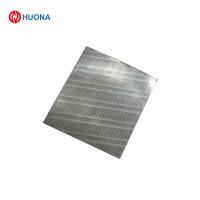4J36 0.4x211mm strip invor alloy DIN17745 FeNi36 strip
HUONA-Alloy-4J36 (Expansion alloy)
(Common Name: Invar, FeNi36, Invar Standard, Vacodil36)
HUONA-Alloy-4J36(Invar), also known generically as FeNi36 (64FeNi in the US), is a
nickel–iron alloy notable for its uniquely low coefficient of
thermal expansion (CTE or α).
The name Invar comes from the word invariable, referring to its
relative lack of expansion or contraction with temperature changes.
It was invented in 1896 by Swiss physicist Charles Édouard
Guillaume. He received the Nobel Prize in Physics in 1920 for this
discovery, which enabled improvements in scientific instruments.
HUONA-Alloy-4J36 (Invar) is used where high dimensional stability
is required, such as precision instruments, clocks, seismic creep
gauges, television shadow-mask frames, valves in motors, and
antimagnetic watches. In land surveying, when first-order
(high-precision) elevation leveling is to be performed, the Level
staff (leveling rod) used is made of Invar, instead of wood,
fiberglass, or other metals. Invar struts were used in some pistons
to limit their thermal expansion inside their cylinders.
Normal composition%
| Ni | 35~37.0 | Fe | Bal. | Co | - | Si | ≤0.3 |
| Mo | - | Cu | - | Cr | - | Mn | 0.2~0.6 |
| C | ≤0.05 | P | ≤0.02 | S | ≤0.02 | | |
Typical Physical properties
| Density (g/cm3) | 8.1 |
| Electrical resistivity at 20℃(Ωmm2/m) | 0.78 |
| Temperature factor of resistivity(20℃~200℃)X10-6/℃ | 3.7~3.9 |
| Thermal conductivity, λ/ W/(m*℃) | 11 |
| Curie pointTc/ ℃ | 230 |
| Elastic Modulus, E/ Gpa | 144 |
Coefficient of expansion
| θ/℃ | α1/10-6℃-1 | θ/℃ | α1/10-6℃-1 |
| 20~-60 | 1.8 | 20~250 | 3.6 |
| 20~-40 | 1.8 | 20~300 | 5.2 |
| 20~-20 | 1.6 | 20~350 | 6.5 |
| 20~-0 | 1.6 | 20~400 | 7.8 |
| 20~50 | 1.1 | 20~450 | 8.9 |
| 20~100 | 1.4 | 20~500 | 9.7 |
| 20~150 | 1.9 | 20~550 | 10.4 |
| 20~200 | 2.5 | 20~600 | 11.0 |
Typical Mechanical properties
| Tensile Strength | Elongation |
| Mpa | % |
| 641 | 14 |
| 689 | 9 |
| 731 | 8 |
Temperature factor of resistivity
| Temperature range ℃ | 20~50 | 20~100 | 20~200 | 20~300 | 20~400 |
| aR/ 103*℃ | 1.8 | 1.7 | 1.4 | 1.2 | 1.0 |
The heat treatment process
| Annealing for stress relief | Heated to 530~550℃ and hold 1~2 h. Cold down |
| annealing | In order to eliminate hardening, which be bring out in cold-rolled,
cold drawing process. Annealing needs heated to 830~880℃in vacuum,
hold 30 min. |
| The stabilization process | - In protective media and heated to 830 ℃, hold 20min. ~ 1h, quench
- Due to the stress generated by quenching, heated to 315℃,hold 1~4h.
|
| Precautions | - Cannot be hardened by heat treatment
- Surface treatment can be sandblasting, polishing or pickling.
- Alloy can be used 25% hydrochloric acid pickling solution at 70 ℃
to clear oxidized surface
|
Style of supply
| Alloys Name | Type | Dimension |
| HUONA-Alloy-4J36 | Wire | D=0.1~8mm |
| HUONA-Alloy-4J36 | Strip | W= 5~250mm | T= 0.1mm |
| HUONA-Alloy-4J36 | Foil | W= 10~100mm | T= 0.01~0.1 |
| HUONA-Alloy-4J36 | Bar | Dia=8~100mm | L=50~1000 |














